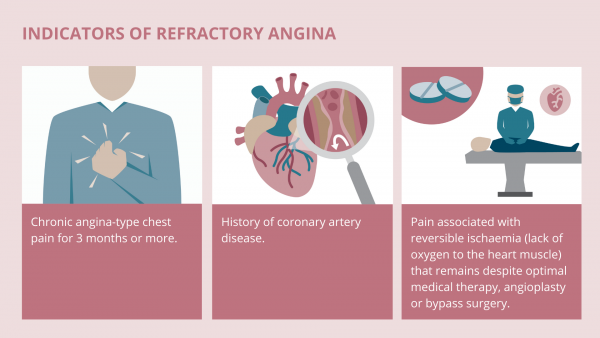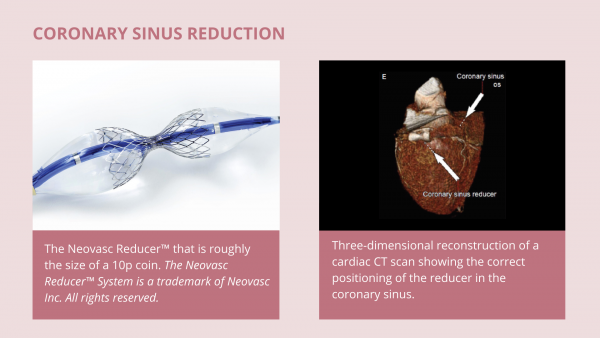Pain caused by refractory angina can be reduced by new therapies available at RB&HH Specialist Care which help to increase myocardial perfusion and reduce the psychological impact of the condition.
What is refractory angina?
Angina is characterised by chest pain caused by an inadequate supply of blood to the myocardium and results from coronary artery disease.
Despite great advances in medical therapies and myocardial revascularisation procedures to treat angina, there are a growing number of patients in whom these conventional treatments remain ineffective. These patients have what is termed ‘refractory angina’.
Patients are diagnosed with refractory angina when they have experienced chronic angina-type chest pain for 3 months or more despite optimal treatment with medication, stents and/or coronary artery bypass surgery.
This could, for example, be due to the patient having very diffuse arterial disease where the arteries are too small to treat with conventional stents and/or functional disorders of the arteries where they have become compressed or unable to dilate, reducing blood flow to the myocardium.
A difficult diagnosis
Diagnosis is challenging and requires careful clinical assessment tailored to the patient’s symptoms combined with specialist investigation. Due to this, the exact number of patients with true refractory angina is unknown. However, estimates suggest that there are 30,000-50,000 new cases each year in Europe and between 600,000 and 1.8 million patients living with refractory angina in the United States alone.
Additionally, the clinical burden is growing due to an ageing population and improved survival from coronary artery disease, as well as conditions such as diabetes which can impair small blood vessels of the heart.
Patients with refractory angina have significantly impaired quality of life with a high incidence of depression as well as poor self-perceived health status. Coupled with evidence that it is not associated with an increased long-term mortality, treatments targeted at improving the symptoms and quality of life of this challenging patient population is key.

Fortunately, treatments are available
The Neovasc ReducerTM, a stent shaped like an hourglass, is used to create a narrowing in the coronary sinus, which is a collection of veins receiving blood from the myocardium. This narrowing increases pressure in these veins to re-distribute oxygenated blood to ischaemic areas.
“It is a quick, safe and minimally invasive procedure that usually takes less than 60 minutes to complete, with patients often discharged the same day,” explains our consultant interventional cardiologist, Dr Ranil de Silva. “We are very pleased to report that in our very complex cases, we have seen that angina and quality of life improves in around 80% of patients after this treatment.”

Holistic multidisciplinary approach to treatment
Randomised controlled trials have unfortunately shown that pharmacological therapies do not significantly improve symptoms and the quality of life of patients with refractory angina. However, home based cognitive behavioural therapy to assist with self-management of symptoms and challenging negative health beliefs can improve patient quality of life substantially. It helps patients to feel more positive about their own health and achieve goals that are important for them.
It has been shown to:
- improve psychological wellbeing, including anxiety and depression
- reduce symptoms to three episodes of angina or fewer per week
- reduce glycerol trinitrate use
- improve functional status, including a reduced physical limitation score and increased daily
- walking
The programme is delivered by our nurse specialists and can be supported by clinical psychologists as part of an ongoing interaction with each patient to help improve their quality of life. We also have online consultations available to prevent patients from travelling long distances.
Contact us
For more information or to book an appointment, please contact our customer care team.

